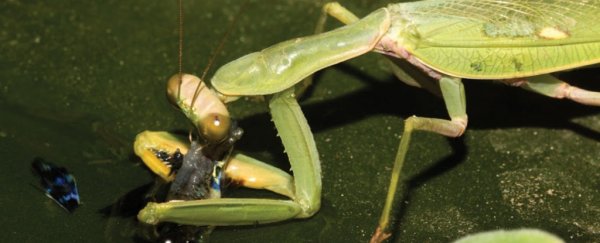Praying mantises catch and eat a lot of different animals. All kinds of insects, lizards, and even frogs, snakes, or small birds if it comes to it. But scientists didn't think fish were on the menu – until now that is.
Researchers have discovered a praying mantis in India repeatedly enjoying a meal of guppies in what they think is the first time this kind of behaviour has been observed and recorded in the wild.
"Mantids can be considered generalist predators but they are known to feed mostly on other insects, especially on fly-like insects," explain the researchers in a new paper.
"Vertebrates as prey for mantids are … based on anecdotal records, mostly from caged or in some way "induced" encounters between mantids and small birds, lizards, frogs, newts, mice, snakes and turtles."
But for this 5.6 centimetre (2.2 inch) mantis, which is a giant Asian mantis (Hierodula tenuidentata) there was no inducing.
 The pond where the mantis was discovered. (Rajesh Puttaswamaiah/Journal of Orthoptera Research)
The pond where the mantis was discovered. (Rajesh Puttaswamaiah/Journal of Orthoptera Research)
The team discovered the fishing mantis because one of the researchers, conservationist Rajesh Puttaswamaiah, saw the insect in his rooftop garden in Karnataka, India.
The garden had a small, artificial pond, filled with 40 guppy fish, as well as water lilies and water cabbage, which is what the mantis (or more specifically mantid) was standing on to get to the fish.
The scientists went to work, documenting five days of encounters between 6:30 pm and 12:30 am. The mantis did not disappoint.
"During the five days, the mantid was observed capturing and devouring a total of nine guppy fish," explain the researchers.
"On the first four of the five days, the mantid was observed to hunt and devour two fish. The second fish was hunted within 10 - 30 minutes of consuming the first one."
After five consecutive days, the mantis no longer returned to the pond.
It's a pretty cool finding, considering the fact fish don't move like other types of mantis prey. As the researchers explain, it's much lower than their usual hunting field, plus there's a water barrier in the way.
And "although the compound eyes of most mantids are appositional, sensitive to movement, and adapted to vision mostly in daylight, this male was able to see and catch the fish under the water at night and to overcome refractive challenges," the researchers write.
"The fish were caught near the water's surface, always after sunset, sometimes late at night and, in general, in low light."
These kinds of challenges make the discovery even more surprising.
"I wouldn't have thought a fish underwater, at night, would have enough contrast to attract a mantid's attention and trigger a strike," Jenny Read, a neuroscientist from Newcastle University with mantis vision expertise, who wasn't involved in the study told National Geographic.
Although it's important to note that this behaviour is pretty weird for mantises, it still asks a lot of questions.
The biggest one is how this mantis learned how to do this. Although we know of mantises learning to avoid toxic prey, this is one big step further in mental capabilities.
Either way, we'll need to do more studies to work out what is really going on here.
"It is a popular belief that insects are simple, hard-wired organisms. In reality, they are capable of stunningly complex behaviours," Gavin Svenson, an entomologist at the Cleveland Museum of Natural History who also wasn't involved with this study said to National Geographic.
"I believe we are just scratching the surface for what we know of them."
The research has been published in the Journal of Orthoptera Research.
